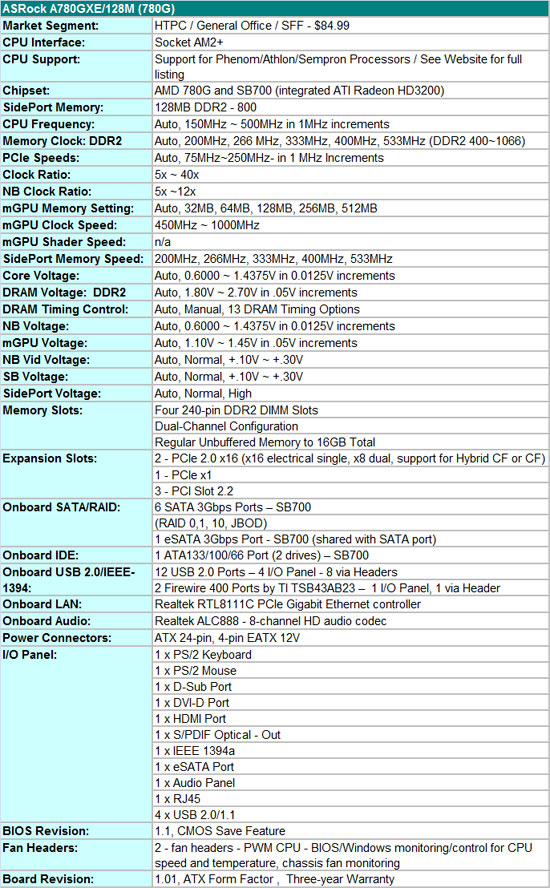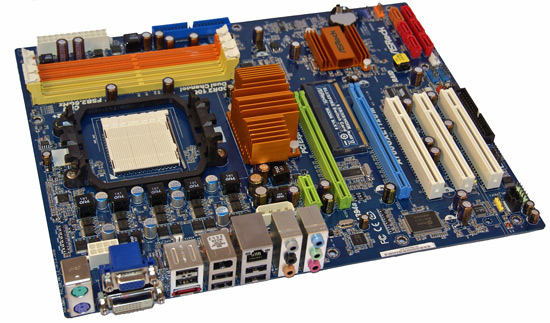The IGP Chronicles Part 2: AMD 780G vs. Intel G45 vs. NVIDIA GeForce 8200
by Gary Key on October 14, 2008 12:40 PM EST- Posted in
- Motherboards
AMD 780G: ASRock A780GXE/128M
The third board in today’s chipset overview is from ASRock. ASRock is typically associated with the low-end market and for offering products based on previous generation chipsets. ASRock has changed considerably over the past year and now offers current generation chipsets, premium features, unique designs, and they are starting to open up to overclocking.
While their marketing (visit the website link above) might be a little over the top for some, their product designs are starting to really impress us based on value/performance criteria. In fact, expect to see a slew of ASRock products reviewed over the coming weeks as we concentrate on the under $150 market space.

The board we are looking at today is the ASRock A780GXE/128M that features the AMD 780G chipset, SB700 Southbridge, and is paired with 128MB of DDR2 Sideport memory. Offered in an ATX format, the A780GXE/128M provides 2 physical x16 PCIe slots (x8 in dual-slot configuration or single x16 operation only), three PCI slots, and a single x1 PCIe connector. Due to the configuration, you can run x8 CF or Hybrid CF on the board. In fact, up the mGPU core clock to 700MHz and you have a 790GX board for $85.

The board also features the Realtek 8111C for Gigabit LAN, Realtek ALC888 for HD audio, TI based IEEE 1394a support, and RAID 0, 1, 10, and JBOD operation. An eSATA port is offered but it means sharing with another SATA port off the SB700. Two video selections are available, VGA or DVI-D output (with HDMI coming via a dongle).
The overclocking options in the BIOS are extensive for a 780G board and nearly match those of the Gigabyte MA780PM-D2SH. We had no problems overclocking a variety of processors on this board and the results matched those of more expensive boards as we will see shortly. The AMD 780G chipset also topped out around 250HTT when utilizing the IGP unit.
The board features an excellent 5-phase power system along with quality capacitors. We clocked our 9950BE up to 236HTT, 8750 at 243HTT, and the 4850e at 245HTT with base memory clock set to DDR2-800 with 5-4-4-15 settings. The mGPU clock reached 750 MHz before we noticed graphical corruption in several game titles. In addition, when overclocking via HTT, we dropped our Sideport memory clock to 400MHz to ensure stability. We had some luck setting Sideport voltage to high and leaving the SP memory speed at 533MHz (1066) up to 225 HTT.
CrossFire operation worked perfectly with two of our Sapphire HD4670 cards and matched the performance of the 790GX boards. We did not need to utilize the additional Molex power connector until we connected two HD4850 cards. Hybrid CF worked fine with an HD3450 card.
Pros/Cons
This is a unique board from ASRock as the features and options place it in direct competition with the 790GX boards for a budget level price of $85. We are still completing overclock testing with the 9950BE and HD4850 setup, but so far the board has held up for over a 100-hour period without a problem. Performance is equal to most of the 790GX boards with a discrete GPU and the same for the IGP unit when it is clocked to 700 MHz.
We did find a couple of drawbacks on this board. The color scheme is just not for us and it eerily reminds of a Gigabyte board. However, color does not equate to performance pitfalls. The PCIe x1 slot only works with half-length cards. A native HDMI port is missing although the DVI-D port fully supports HDCP. We had hoped that ASRock would have utilized their ALC890 HD audio chipset, but that and a DVI-HDMI converter is what basically separates this board and their upper market 790GX product. Finally, only two fan headers on an ATX board designed for the home market is unacceptable today.
Overall, the A780GXE/128M is a unique product offering in the 780G market and an excellent value at $85. This is a board that is a little quirky at times and might not be perfect, but maybe that is the reason why we like it so much. As such, we highly recommend this board for those looking for 790GX performance at a 780G price.















41 Comments
View All Comments
MrMilli - Tuesday, October 14, 2008 - link
If you multiply it all out that gives Intel a throughput of 8 instructions per clock for G35, 10 for G45, 10 for NVIDIA's GeForce 8200 (where two are transcendental operations) and 40 for AMD. In terms of worst case throughput however, AMD falls down to 8 per clock (assuming the compiler can't feed the hardware 4 shader ops + 1 transcendental per SP) as does NVIDIA. This worst case rarely happens, but it is definitely worth noting.10 for nvidia => 8 for nvidia
AMD falls down to 8 per clock => to 10 per clock
a1yet - Tuesday, October 14, 2008 - link
wow finally a video playback comparison :-) TYI have a question one of you may be able to answer ?
In the "Hardware Accelerated Blu-ray Playback Comparison"
(CPU usage) the 780 beat the 790 in 3 of the 6 tests!
With the 790 using up to 9% MORE CPU usage, and in the
other 3 tests. The 790 beat the 780 by only .3% (well within a margin of error)
Up to 9% MORE CPU usage is A LOT!
I want to buy the 790 but this is a disappointment!
Dose anyone know why the 790 uses so much more CPU then the 780.
Is it's HD Acceleration sub-par ?
Heck in the "Crank DB" test all the cards beat the 790.
Please help TY
yknott - Tuesday, October 14, 2008 - link
Do we know if the Radeon HD4xxx cards support output at 1080p/24fps?I did some googling and can't find anyone who can verify this
Geraldo8022 - Tuesday, October 14, 2008 - link
"do we know if the Radeon HD4xxx cards support output at 1080p/24fps?"this is exactly what I want to know also.
Screammit - Wednesday, October 15, 2008 - link
I just received a 4670 today to plug into my old PC that i'm slowly converting into an HTPC. In the display modes 1080p/24 is natively listed, but i'll have to get my blu ray drive in before I can truly verify that it works. Sure seems to have support though.Calin - Tuesday, October 14, 2008 - link
An Intel processor and chipset with an AMD discrete cardSkCom - Tuesday, October 14, 2008 - link
testing amd ddr 2 and intel ddr 3 is not fer test and amd made the 780 790 for usage with cheap cpu SEMPRON so why use phenom and rise the w power when simply can do the chep cpu psu ram and stillwatch HD movies surf and dissant gaming price perfom AMD 1 CHAMPION
strikeback03 - Tuesday, October 14, 2008 - link
Checked twice, can't find any punctuation in this post. I have no idea what you are trying to say.fic2 - Tuesday, October 14, 2008 - link
Apparently using a Sempron takes away your ability to punctuate, spell check or make much sense.Clauzii - Tuesday, October 14, 2008 - link
He says that by using a Sempron CPU (lower watt than Phenom), it would still be a nice machine for most people, and still be good for movies.